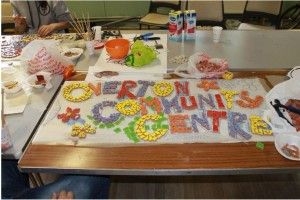
Overton Community Mural Project received funding following SURF’s PB exercise in Kirkcaldy.
Community Choices
This week, a further £2 million has been announced for participatory budgeting projects by Scottish Government Minister Marco Biagi, through a new Community Choices Fund.
The resource is focused on supporting community organisations and public bodies in more disadvantaged areas to work together spending decisions for their local area.
This article takes a brief look at what participatory budgeting is and how it works in Scotland.
What is participatory budgeting?
Based on the Scottish Government definition, participatory budgeting (PB) is a method that allows local communities to have a direct input into how and and where public funds can address local requirements. The concept was first established in Brazil in 1989, where there were significant restrictions on public funds. PB allowed those in deprived communities to become empowered through direct participation in decision-making within their communities. As the process proliferated around the world, it has been recognised as a good practice by major institutions such as the World Bank and UNESCO.
Ideally, PB should be underpinned by a range of values and principles that provide communities with genuine ownership and empowerment over influencing and shaping local budget priorities in their area. This should involve direct engagement with all parts of the community, enabling full representation. PB values are founded on a common standard of shared responsibility, where local people are given a respected role in the discussion, voting, scrutiny and monitoring of the process. In addition, communities should be provided with full information on public budgets, even those over which they do not have a direct input.
How does participatory budgeting work in Scotland?
Participatory Budgeting is not a novel concept to Scotland. It was, however, first formally discussed during the initial consultation on the Community Empowerment and Renewal (Scotland) Bill in 2012 with the premise of ‘giving local people a greater say in local budget decisions’. Although PB was ultimately not legally enshrined in the subsequent Community Empowerment (Scotland) Act of 2015, it is still viewed as part of the Community Empowerment agenda.
The 2015 Act gives the Scottish Parliament powers to legislate for participatory approaches, including participatory budgeting. PB also ties in well with the newly created Fairer Scotland programme, where it is hoped that decentralising power to a local level should help communities to contribute meaningfully towards addressing inequalities and making budget decisions on their own terms. In the context of public sector cuts, PB can allow the community to help decide on budget priorities and consider solutions, as well as providing them with a greater understanding of current financial difficulties facing governments.
In terms of organisation, PB in Scotland has largely taken the form of local level pilot projects with small, discrete funding pots allocated to voluntary and community groups from the Scottish Government and other organisations. Some local authorities, such as Dundee City Council and Fife Council, have developed a good reputation for establishing PB forums in selected communities. In addition, other funding is available from sources such as the Charrette Funding programme, intended for interactive Charrette workshops where the community and local stakeholders are invited to put forward ideas for the future development of their area. Linking this with participatory democracy initiatives, including PB, is currently being encouraged through the latest iteration of funding, particularly to deliver Charrette outcomes. Its proponents believe, however, that there should be a move towards allocating mainstream public budgets to PB.
The format of PB decision-making can be flexible to local circumstances. For example, the process can involve a joint committee that develops proposals for budget allocations and projects. As well as, or alternatively, it can involve holding open events for anyone to attend and participate in funding decision-making processes. One of the first PB pilots, carried out in Govanhill in Glasgow, provides an example of a mix of these approaches. The funding for this project, intended to address the area’s significant social, economic and health inequalities, was allocated to the newly established Govanhill Community Action (GoCA) group.
A wide variety of community groups were invited to join with the GoCA to take part in focus group discussion, which eventually culminated in deciding upon proposals for the local area. Although improvements could have been made in terms of representation and transparency during the process, the GoCA embraced their responsibility by using the funds strategically and ambitiously, taking advantage of local insight and creating a uniquely ‘purposeful and reciprocal dialogue’ between stakeholders.
SURF is interested in the way in which participatory budgeting can effectively be used to support community regeneration. As part of SURF’s Alliance for Action initiative, SURF facilitated a successful Participatory Budgeting exercise using seed money from Creative Scotland. The report is available here.
